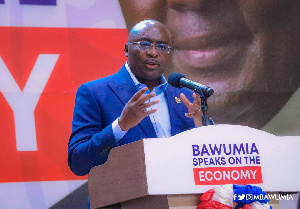The Vice President of Ghana, Dr. Mahamudu Bawumia’s address on the economy as delivered at the National Tertiary Students Confederacy (TESCON) Training and Orientation Conference at Kasoa in the Central Region, on April 7, 2022, surely got the nation talking a lot, also too because of the high expectations that heralded this event.
The vice president, considered one of the most knowledgeable people on subjects of the economy in the country, had been silent on a lot of happenings in the country, while many Ghanaians who were concerned, yearned to hear him address those issues.
From the rising cost of fuel to the Electronic Transactions Levy (E-Levy), the effects of the Russia-Ukraine war on Ghana’s economy, the ravages of the novel Coronavirus, among other topical subjects on the economy, Dr. Bawumia made a relatively good attempt to touch on all of them in his over an hour-long address.
GhanaWeb, after analysing his address, has put together all the times that the vice president made references to ‘data’ in supporting his arguments on all of the things he spoke about.
Here are all the 17 times as contained in his address:
• Today, I will address these questions based on data and facts, I will admit where there are challenges and hopefully we will all leave here with a better understanding of the state of the economy
• What is the data saying about key variables like Inflation, interest rates, external sector performance, fiscal 9 10 balance, debt stock, GDP, and the exchange rate?
• Indeed, the data (Table 3) shows that in the UK and US for example, inflation is accelerating at three to four times its rate in 2019 (before COVID)
• In fact, the data supports this view
• The data (Table 5) shows that the three items of expenditure cumulatively amounted to GHC 50.1 billion (the equivalent of some $7 billion), financed from borrowing
• The data (Table 6) shows that the expenditure on these flagship programs over the five year period between 2017 and 2021 amounted to GHC15.62 30 billion compared to the GHC 50.1 billion expenditure on the three exceptional items
• The data (Table 7) shows that the debt to GDP ratio after COVID-19 increased in the US, UK and Cote d’Ívoire by 12, 18 and 12.3 percentage points of GDP respectively
• Despite these tax reductions, the data shows that revenue collection in nominal cedi terms has increased by 25% annually since 2017
• The data for the first three quarters 57 of 2021 indicates a massive growth of 10.1% in the agricultural sector (Figure 14)
• The evidence and the data is therefore clear that we have made good progress in shifting from a focus on taxation to a focus on production
• Based on World Bank data, the average unemployment rate in Ghana between 2014 to 2016 which stood at 6.29% declined to an average of 4.37% between 2017 to 2020
• The data (Figure 18) shows a clear dichotomy for the depreciation of the cedi between 2013-2016 and 2017 – 2021
• The data (Table 13) shows that average exchange rate depreciation during the 2017-2021, at 6.8% under our government, is more than twice as stable than during the 2013-2016 period where the average depreciation rate was 18%
• Data from the Bank of Ghana shows that at the end of March the cedi had depreciated by 15.5% (Figure 20)
• Given the uncertainty surrounding geo-political developments and their impact on the economy, we will continue to monitor the data and are ready to take further measures as may be required to meet our budget targets
• In summary, the data clearly shows that overall, notwithstanding the impact of COVID-19, the economic fundamentals of inflation, interest rates, exchange rates, GDP Growth, trade balance, current account balance, gross 78 international reserves during the 2017-2021 period are largely much stronger than they were in the 2013-2016 period
• The data shows that because of MMI, Ghana is the fastest growing mobile money market in Africa
 Home Of Ghana News Ghana News, Entertainment And More
Home Of Ghana News Ghana News, Entertainment And More





